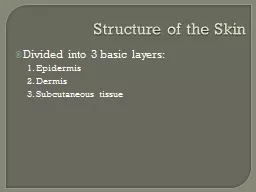

Divided into 3 basic layers 1 Epidermis 2 Dermis 3 Subcutaneous tissue Epidermis top level Made up of 5 cell layers from bottom to top Basal deep Spinus Granular Lucidum Corneum superficial ID: 528440
Download Presentation The PPT/PDF document "Structure of the Skin" is the property of its rightful owner. Permission is granted to download and print the materials on this web site for personal, non-commercial use only, and to display it on your personal computer provided you do not modify the materials and that you retain all copyright notices contained in the materials. By downloading content from our website, you accept the terms of this agreement.
Slide1
Structure of the Skin
Divided into 3 basic layers:
1. Epidermis
2. Dermis
3. Subcutaneous tissueSlide2
Epidermis: top level
Made up of 5 cell layers (from bottom to top):
Basal (deep)
Spinus
Granular
Lucidum
Corneum (superficial)Slide3
Basal cell layer
Deepest layer
Cells are
continually dividing to produce new skin cells
(millions daily)
These cells
move towards the skin surface,
Blood is provided by the dermis belowSlide4
Spinus cell layer
Cells
above the basal
cell layer
become more irregular in shapeSlide5
Granular cell layer
C
ells are moving away from the blood supply, the cells begin to flatten and die
Keratin
begins to form in the cells
.
Slide6
Lucidum
cell layer
Clear-ish
layer of skin
Only found where the
skin is hairless and extra thick
lots keratin to provide water-repellent
propertiesSlide7
Stratum Corneum
Layer of
skin we SEE
Made up of
overlapping squamous cells
Cells are
dead and constantly shedding
These cells provide the tough and watertight function of skinSlide8Slide9
Dermis layer “hide”
Contain many of the structures
that are found within our skin.
Arteries
and
veins
run through this layerSlide10
Structures of the Dermis
Cutaneous glands
Sebaceous gland
Sweat glands
Hair
Nails
Nerves
Collagen and elastin fibersSlide11
Cutaneous Glands
All
exocrine glands that release their secretions to the skin surface via ducts
2 groups:
Sebaceous glands
Sweat glandsSlide12
Sebaceous Glands
Glands
that secrete
sebum (oil)
Ducts empty out into hair folliclesSlide13
Characteristics of Sebum
Lubricant that
keeps skin soft and moist
Prevents hair from becoming brittle
C
hemicals that kill bacteria
The gland becomes
highly active during adolescenceSlide14
Acne
S
ebaceous gland’s duct becomes blocked by sebum
A
whitehead forms on skin surface.
If the
material oxidized and dries
, it darkens and becomes a
blackheadSlide15
Sweat Glands
More than
2.5 million
per person
2 types:
Eccrine
: found
all over the body
Apocrine
: found only in
genital and axillary regionsSlide16
Sweat
Made up of
water,
NaCl
, vitamin C, metabolic wastes, and lactic acid
Ducts that lead to the surface
of the skin are called
poresSlide17
Sweat Gland and PoreSlide18
Homeostatic Uses of Sweat
Supplied with
nerve endings that cause them to secrete sweat when outside or body temperature is too highSlide19
Hair
Earlier humans had more hair for insulation and self defense
Current uses for hair:
Guarding head against minor impact
Shielding the eyes
Keeping particles out of respiratory organsSlide20
Structure of the hair
Root
:
enclosed in the follicle
Shaft
:
projecting out of the scalp
Hair bulb matrix
: Inferior end of the follicle. Where new hair is formed.Slide21
Hair Follicles
Where
hair forms and attaches to the body
Made of
2 layers
:
Inner
epidermal layer
:
forms the hair
Outer
dermal sheath
:
supplies blood and reinforces hair to bodySlide22
Arrector pili
Small bands of
smooth muscle
cells
When contracted the hair is pulled upright, dimpling the skin surface “goosebumps”Slide23
NailsMade up of
keratinized skin cells
Scale-like modification of the epidermis that corresponds to the hoof or claw of other animalsSlide24
Subcutaneous layer
The
innermost layer of the skin
Composed of
fat
thickness varies upon body region
This layer performs 2 major functions:
energy source
for the body
helps
to insulate the body against temperature
.